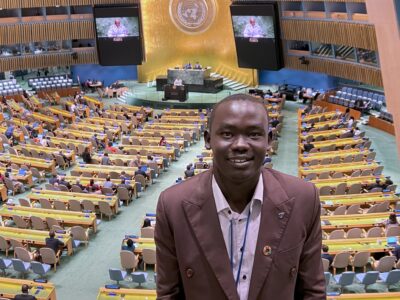
For more information about this new certificate program and its curriculum, please visit the program website. The deadline to apply for Fall 2013 enrollment is May 15th. Please visit the admissions website for more information on how to apply.
The below interview was conducted by Nick Turchak, a student in the M.S. in Sustainability Management program. In this interview, Naresh elaborates on his research topics in Hydro-climatic Data Analysis and Modeling, Water Resources Management and Risk Assessment.
Why did you choose water as a focal point of your career and research efforts?
Frankly, until the completion of my undergraduate degree I was not sure about my career path. It was only after I started graduate school at North Carolina State University that I got exposed to a domain of issues related to Hydrology and Water Resources and learnt that there exists a range of uncertainties in solving real world water problems. Managing water resources was particularly fascinating as the impacts are seen at all possible time (daily to seasonal to yearly to multiple years) and spatial (regional to global) scales. Some projects I worked on as a grad student on linking climate information to reservoir operations got me interested in large scale systems analysis. I continued my PhD research at NCSU and Post-doctoral research at Columbia University on understanding these large scale issues in hydroclimatology and their relations to oceanic, atmospheric, and land surface conditions and issues of global and regional water sustainability. Now, my primary research interest is in understanding and modeling water systems and developing integrated risk management methods using multi-scale climate information.
What research do you focus on at the Columbia Water Center?
At Columbia Water Center, I am working on multiple issues ranging from water sustainability, regional risk assessment, understanding long term climate variability and developing predictive models for managing climate induced risk.
For example, for some projects that Columbia Water Center is conducting in India one of the greatest concerns was to quantify and develop solutions for the problem of water sustainability in India. I worked with fellow scientists at the center to develop water stress indicators at resolutions that are crucial to decision makers. The stress indicator will inform the magnitude of stress as a function of local water availability. It will inform how much out of kilter a region is from its normal. Once we have a reasonable understanding of stress in a region, the type of solutions can be at multiple levels, ranging from devising local storage needs to informing policy changes in order to reduce the water stress or balance the system. We also developed seasonal forecasts for these indicators that can inform water management choices.
Some of the other projects I am working on involve understanding the long term climate variability for the New York region using paleo-information. This is critical since the city’s reservoirs have a looming risk of the recurrence of the 1960s drought spell. Together with the scientists at the Lamont Tree Ring lab, we are developing streamflow paleo-reconstructions for the city’s reservoirs to get a historical perspective of the regional water resources. We can overlay this long record with current city’s demand patterns to see how resilient the operations are with respect to climate.
How do you develop the climate scenarios that accurately represent uncertainties?
Properly representing the uncertainties in climate scenarios is a key aspect for developing strategies for adaptation to climate change and variability. If we can properly estimate the range of values that the future or past climate can take, it is easy to devise strategies for extreme case situations. Over estimation of these extremes will lead to overly conservative rules and underestimating them will lead to system failures. Hydrologists typically work with finite datasets with significant variations from one location to other, and it becomes necessary to accurately replicate these variations in the models using the limited data. Using Hierarchical Bayesian models for such high dimensional problems is advantageous due to their ability to explicitly quantify the process model and parameter uncertainty at multiple levels. Using Bayesian methods we can indeed find ways to reduce uncertainty by appropriate pooling of information across locations. We used these techniques for the paleo-reconstruction for NYC reservoirs. The models were set up such that the spatial variability from one reservoir to the other is being preserved while the information across all the reservoirs is appropriately pooled to reduce the uncertainties.
So, in general and accessible terms, in what way these modeling techniques can help us understand what to expect from our changing climate and how to plan for these variations?
These models can serve as the necessary building block for simulating water system operation and to provide a more objective evaluation of operating rules for reservoir systems consider changing conditions. Like I mentioned above, once we develop these climate scenarios, we can run various what if scenarios to see how the system responds to such changes. It is also possible to get insights into the probability of a region being under severe drought or its possible linkage to large scale climate patterns like ENSO or PDO. Going back to the NYC reservoir example, using the paleo-reconstructed streamflow as input to the current water supply rules, we were able to find that the 1960s drought is by far the worst drought in 246 years since 1754. However, there are intermediate drought warning periods and proper adaptation during these times would be sufficient. The current release rules for the city appear to be conservative, and modification can be explored to increase releases to downstream stakeholders without much stress to the system during most periods.
You’ve also mentioned risk management. Are there ways to quantitatively assess water risks?
Yes. It can be viewed both in terms of average stress, i.e. how vulnerable a region is on average, and as cumulative stress that captures the variability or periodic shocks to the region. In my view quantifying risk as cumulative stress is much more informative for decision makers as it directly informs the resilience of the region. Imagine two regions with same average supply and demand, but one region has more exposure to periodic droughts and one region has a constant water supply throughout. If we measure stress for both regions, one average both regions will have similar risk, but it is obvious that the region with more exposure to periodic droughts is riskier in terms managing water resources and developing related businesses in that region. These are the things we are trying to capture in our water stress tool developed recently for India. The cumulative water stress tool will inform the cumulative stress resulting from periods of low water availability or high demand. Appropriate adaptation or planning measures can be taken during high risk periods.
Based on your findings, what do you think should be included into the adaptation strategy for agriculture in northern India?
North India, especially the states of Punjab and Haryana have a significant contribution towards food security in India. In fact, these were the targeted regions for procurement of major food grains like rice and wheat since the green revolution in 1960s. Essentially, the government is serving as a contract farming operator with targeted regional procurement at stable prices for selected grains. This has led to a significant change of the regional cropping patterns away from traditional crops that were adapted to the local climate and soils, and increased demand for irrigation. The areas targeted do not match the areas that would be most suitable from the perspective of adequate water availability to match the crop water demand. As production increased over time, Northwest India has now become a case where demand is exorbitantly higher that its available water supply and deficits are being met by ground water. As a consequence of this imbalance, the region is now experiencing drastic depletion in its groundwater reserves. The ridiculously low cost of electricity for farming discourages any economic sense of saving and optimizing on available resources. While some of the immediate adaptation strategies can be to improve application efficiency on farms or pre-season crop choices based on some monsoon forecasts, in the long run, I believe, unless there is proper pricing on electricity and perhaps a shift in the procurement strategy from the government, the situation will not improve. A local as well as a national crop diversification and marketing needs to be pursued in a manner that is water and climate informed. Much of these can be possible with policy changes, and proper scientific analysis needs to be done to inform such policy decisions.
How do you integrate assessment of food and energy risks into this framework?
Food, water and energy security are interrelated and should be examined conjunctively. The basic question is whether all of the above could be achieved without undue water stress and with minimal energy intensity. In India, poverty is closely related to agricultural productivity, market prices, and the cost of cultivation. One of the significant contribution of our research on the nexus of food, water and energy is a national level optimization framework for cropping patterns across the country that can maximize net agricultural income while meeting food production and water use targets and minimizing irrigation and the associated energy use. This will provide the necessary scientific impetus at the national scale that identifies feasible regions and the crop choices that can support food security and productivity enhancement in a sustainable manner. We believe that this framework can serve as a basis for national policy reform for stimulation of the agricultural sector. Both the public and the private sector could use such analyses to direct procurement strategies that promote water sustainability. In short, I believe this analysis can contribute directly to informing the development of a modern agricultural supply chain for the country.
Are you planning to further expand this framework for agricultural decision-making around the world?
This is precisely the focus of my continuing research. We want to combine changing climatic factors, global trade markets and productivity enhancing measures into the analysis of water sectors in India, China and the United States. The measures to be considered will include comprehensive policy and technology strategies for water storage, distribution, crop choice, and on-farm water, fertilizer and pesticide application. Since the agricultural economy is in large part, dependent on rainfall patterns, (especially true for the Asian monsoon), a key way to improve regional water situation is to provide probabilistic climate and yield information a season ahead to facilitate water and agricultural sector planning within and across nations. At the Water Center, I am currently directing the project on a prototype global risk forecast tool that develops: 1) region specific indicators for assessment of water risk; and 2) statistically verifiable models for issuing season ahead probabilistic forecasts for regional production shortfalls.



